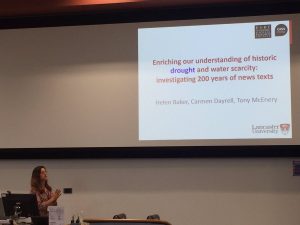The notion that it always rains is a pillar of the British psyche, but does it really? Real droughts only occur in far-away lands, or do they? But the truth is that water scarcity can be both common and very localised, and even when very local it can still have significant impacts. The current situation in a part of the Wye catchment, illustrates this well.
2017 was a dry year. Figure 1a shows early spring and summer rainfall expressed relative to the average in the last 30 years. Brown patches (see the red circle) over Herefordshire point to particularly low rainfall in parts of the Wye river catchment in August and September 2017 (Figure 1b+c). Taking the six months from April to September as a whole, shows a shortage of rainfall along this part of the English-Welsh border (Figure 1d). Figure 3 shows that October was also a very dry month for the whole country.
Does such a localised shortage of rainfall really matter? Probably not for most people; our reservoirs and water supply systems are designed to cope with periods of low rainfall, ensuring water reaches your tap. So unless you are a farmer dependent on rain, we are generally protected from shorter term water scarcity.
But what of the natural environment? Low rainfall can have a direct impact on river flows. The extent to which river flows are affected depends on the catchment (the geographical area from which water flows into a river system). It also depends on your local geology, and whether these rocks are able to store water. Some catchments, like chalk streams, are quite robust because water filters through the rock during period of high rainfall, is held there and is then released when it’s dry.
But the Wye is not a chalk stream and the geology in this area does not allow water to penetrate easily and be stored as groundwater. Instead, when it rains heavily in the Wye catchment, most of the water runs off, leaving the catchment. Without this groundwater supply, the Wye is vulnerable, even when the dry weather lasts only 6 months. Our river plants and animals are used to summer periods with naturally lower river flows, but they are not adapted to extended periods of low rainfall. Unlike countries where rivers dry up seasonally, our river wildlife have not evolved ways of surviving these harsh conditions.
So, if you are a fish in the Wye catchment, recent dry weather spells bad news. In fact so bad, that in some areas flow was so low that the river had separated into pools. In the River Dore near Peterchurch, Herefordshire, earlier this month (13 to 16 October) the Environment Agency had to rescue fish stranded in diminishing pools of water. On the 14th October, 47 trout, 24 lamprey and 8 eels were rescued and moved to safety by Environment Agency staff. These problems have not just been limited to the Wye catchment. On the 16th October the Environment Agency’s Chris Bainger tweeted to draw attention to the fact that water levels on the River Teme at Ludlow in the adjacent Severn catchment, were so low that they were preventing the upstream migration of salmon.
Since then, we’ve had rain, so it’s all right now? Well, no. Recent rain has had little effect on water levels and fish rescues continue, with minnow recently removed from what remained of the Eign Brook in Hereford.
These examples highlight the severe impacts to fish and other wildlife that can occur during periods of localised water scarcity. Sustained dry weather can lead to complete loss of habitat as rivers break into pools that dry up. Important ecological functions such as salmon migration are also disrupted, as just one indicator of fragmentation of connected habitats upon which river life and natural processes depend. Climate change is likely to increase the frequency of these periods of low rainfall and what might seem a freak incident this year is likely to become a more regular occurrence in the next decades.
The Drought and Water Scarcity research programme, funded by UK Research Councils, is addressing these concerns. We would like to hear from you about the ways dry weather is affecting your river systems. If you have stories like the ones above, and would like to contribute your views or would just like to stay in touch with developments in the research programme, please contact the co-ordinator of the environment work stream, Associate Professor Nevil Quinn (nevil.quinn@uwe.ac.uk). Further information can be found elsewhere on this website, including more information about the Drought and Water Scarcity research programme.
Article authors: Nevil Quinn*, Emma Weitkamp*, Francois Edwards+ and Cédric Laizé+, 26 October 2017
* University of the West of England, Bristol + Centre for Ecology & Hydrology, Wallingford

